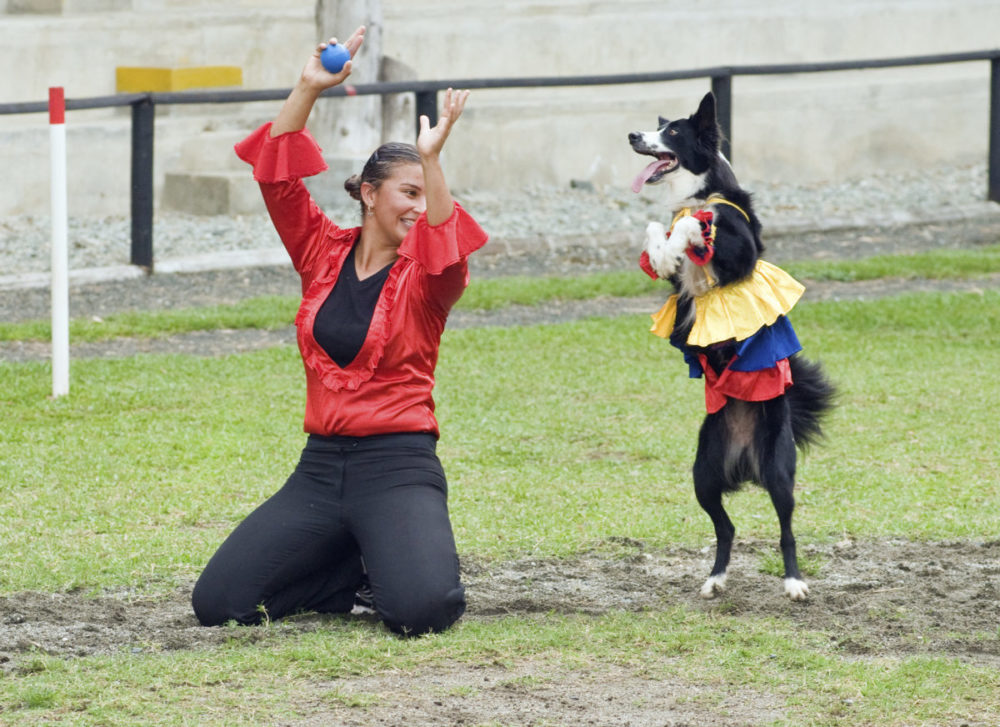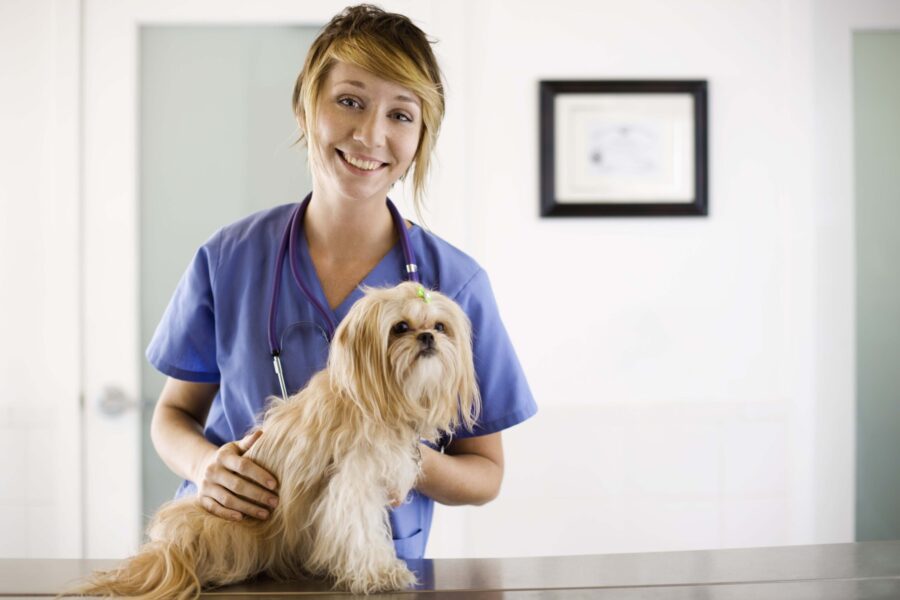Kevin Costner danced with wolves. On television, there’s Dancing with the Stars. I dance with dogs – at nursing homes, hospitals and special needs schools. Hollywood and ABC have yet to call.
Musical canine freestyle is the ultimate in dog dancing and an increasingly popular sport, with costumed human/canine teams competing in sophisticated dance routines at international events. “Musical freestyle is a choreographed musical program performed by handlers and their dogs,” says Patie Ventre, founder of the World Canine Freestyle Organization. “The object is to display the dog and handler in a creative, innovative and original dance, using music and intricate movements to showcase teamwork, artistry, costuming, athleticism and style in interpreting the theme of the music.”
It all started in 1989 when Val Culpin of British Columbia, Canada developed the sport. Dawn Jecs of Puyallup, Washington and her border collie Checkers were the first to do a dance routine at a seminar. Today, WCFO has 5,000 members and 40 chapters worldwide, including Australia, Japan, the United Kingdom, the Netherlands, Canada, South Africa, the United States, and most recently, Israel and Germany.
“Step, two , three”
Canine freestyle is based on obedience training, so if you want to try dancing with your own dog, he needs to be able to obey training commands. If he’ll work from hand signals, you’ll hear the “oohs” and “aahs” over the music! According to WCFO, there are three steps to becoming a canine freestyle team:
1. Start by selecting a musical composition to dance to. Choosing a song is fun. Listening to it 400 times while matching obedience moves to the beat is not, so pick a song you love and that your audience can identify with. I hope when I’m living a nursing home, someone will come and dog dance to Iron Butterfly’s Inna Godda Davita or the Bee Gees high-pitched Stayin’ Alive!
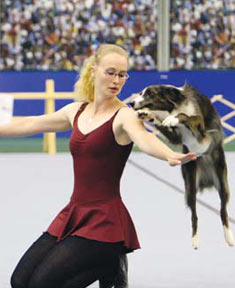 2. Next, you need to choreograph a routine. “This means you should design steps and movements for yourself and your dog to execute that relate to the music you have selected,” says Patie. “They may be comprised of basic obedience steps, dressage movements, tricks or any new step you may create.”
2. Next, you need to choreograph a routine. “This means you should design steps and movements for yourself and your dog to execute that relate to the music you have selected,” says Patie. “They may be comprised of basic obedience steps, dressage movements, tricks or any new step you may create.”
The determining factor in choreography is the amount of space available, depending on where you’re going with it. I have found, for example, that nursing homes will say, “Yes, we have a 15’x15’ space for dancers,” but the space will also contain an atrium or aquarium, 20 wheelchairs, and at least one person attached to an IV. Freestyle dancing at competition level involves more generous spaces – from 1,200 to 2,400 square feet. Cushioning or matting is needed on floors to prevent falls, since many performances include jumps or quick moves.
3. In canine freestyle, costumes are a must. “Your outfits should coordinate with the theme of the music you have selected and be pleasing to an audience.” A dog who will tolerate a hat, sunglasses or a Hawaiian shirt gets attention by adding color and theme to your routine. “Once you have completed these three basic steps and put it all together, you now have a musical canine freestyle performance that you can take to a demo or competition event,” advises the WCFO website.
Can any dog dance?
Some dogs may not like performing and shouldn’t be forced, but in general dogs and music seem to go together. All ages and breeds, mixed breeds included, can be great dancers. “Sassy Seniors is Freestyle for dogs over nine years old and/or handlers over 65,” says Patie. “Handi-Dandi Dancers is for creatively challenged dogs and/or handlers. One of our members dances with a blind golden retriever.
” Dogs as small as Pomeranians or as large as mastiffs can enjoy dance if you shape the moves to their size and speed. There is no easiest or hardest thing to teach; watch your dog to see how he moves naturally. Does he turn around three times before lying down? If so, you can teach him to spin. Does he jump up on your legs? Let him jump, lure him behind you with a treat, and start walking. You’ve taught him to Conga, which makes a great exit for your routine.
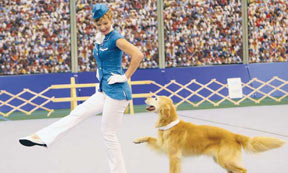 The best moves
The best moves
Your dog will have her favorite routine – my Izzie loved Boogie Woogie Bugle Boy but hated Boot Scootin’ Boogie because she had to wear a cowboy hat. At the end of the dance, we raised our hats and yelled “Yee-haw!” Izzie took this opportunity to lift a paw and scrape the hat off her head. The best moves are the ones your dog discovers herself.
A dog can and will embarrass you in a number of ways, so humiliation is pretty much guaranteed. One day at a nursing home, when St Louis Blues cued, I started off in march step only to feel the leash tighten. I turned and saw my Izzie sitting up, her back to the audience, engrossed by fish swimming in a big tank. We’d forgotten to train for fish distraction. “If the dance move or trick you’ve bragged about goes south, think fast and come up with a new line of patter,”
“Freestyle for me is the ultimate in creativity and challenge,” adds Gaby Grohovaz of South Africa. “In no other dog sport do you have the possibility of this true interaction with your dog. I love the ‘free’ in freestyle.
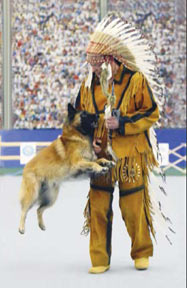 “There are no compulsory moves. The entire routine, the training and discovery of new moves or the combination of moves is left to your own imagination It forces you to be very observant and intuitive to your dog’s abilities, likes, dislikes and general movement. You must work with your dog rather than only teach your dog. It is for you to identify what each dog has to offer. At the higher levels of freestyle we see moves that dogs have invented themselves during training, and it is those moves that make a routine stand out.”
“There are no compulsory moves. The entire routine, the training and discovery of new moves or the combination of moves is left to your own imagination It forces you to be very observant and intuitive to your dog’s abilities, likes, dislikes and general movement. You must work with your dog rather than only teach your dog. It is for you to identify what each dog has to offer. At the higher levels of freestyle we see moves that dogs have invented themselves during training, and it is those moves that make a routine stand out.”
Whether you dance with your dog in your living room, at nursing homes or schools, or compete for professional titles, there is perhaps no other activity that creates a closer bond between you and your dog. It’s also good exercise – for body and mind, dog and human. So give it a try: waltz with your whippet, cha-cha with your chow, or tango with your terrier! For more information on musical canine freestyle, including membership, recommendations for trainers, conferences, workshops and seminars, visit worldcaninefreestyle.org.
Playlist
Izzie and I have danced to the following:
•Boogie Woogie Bugle Boy
•St Louis Blues
•Singin’ in the Rain
•Theme from Rawhide
•Alley Cat
•The Entertainer
•Boot Scootin’ Boogie
•Great Balls of Fire
•Put on a Happy Face
•Popcorn
Additional suggestions:
•Puttin’ on the Ritz
•Ballroom Blitz
•Me and My Shadow
•My Best Friend
•In the Mood
•Poodle in Paris
•Centerfield
•She’s a Lady
•Sugar Sugar
•Pennsylvania 6-5000
•Crazy Little Thing Called Love
•Baby Elephant Walk (especially for large dogs)

